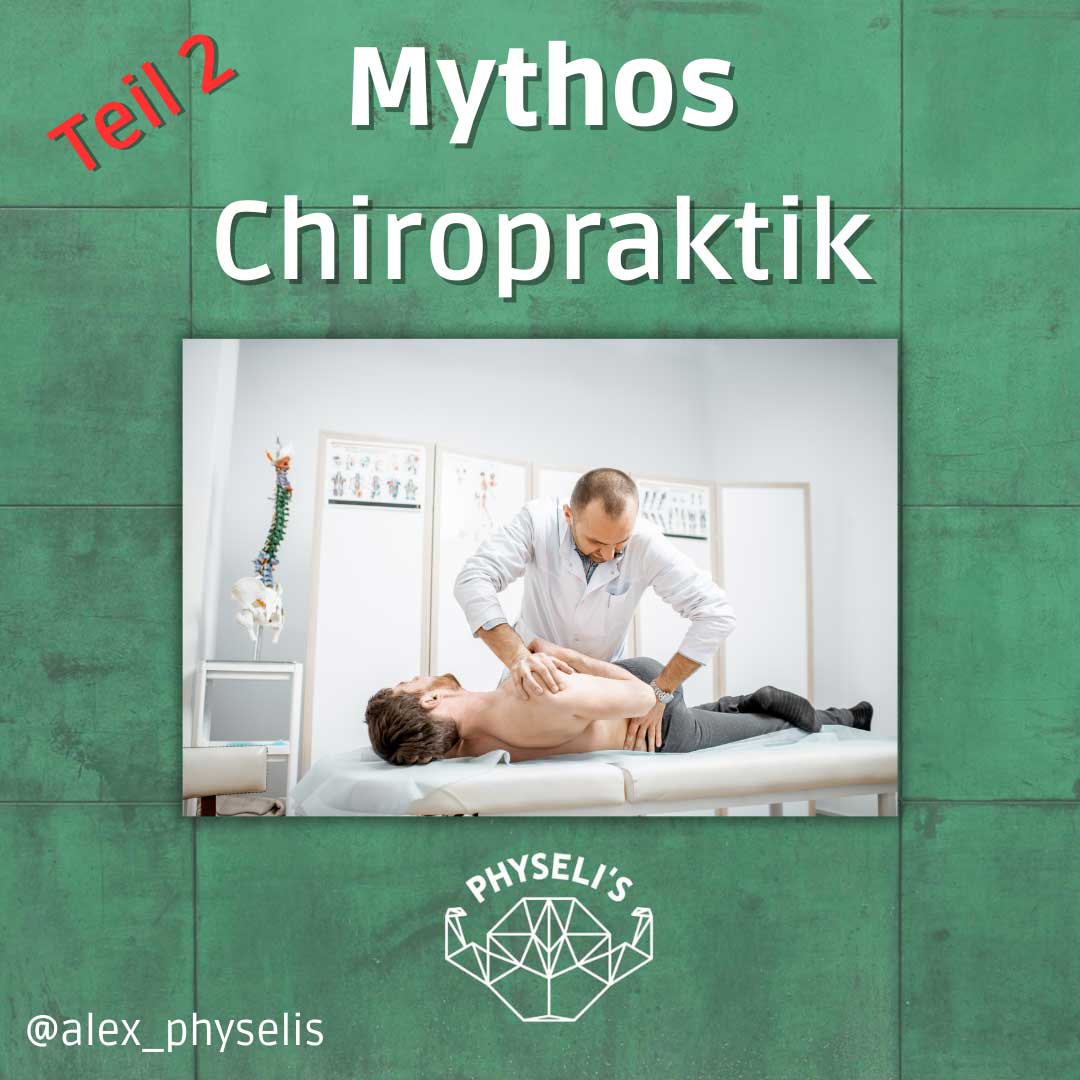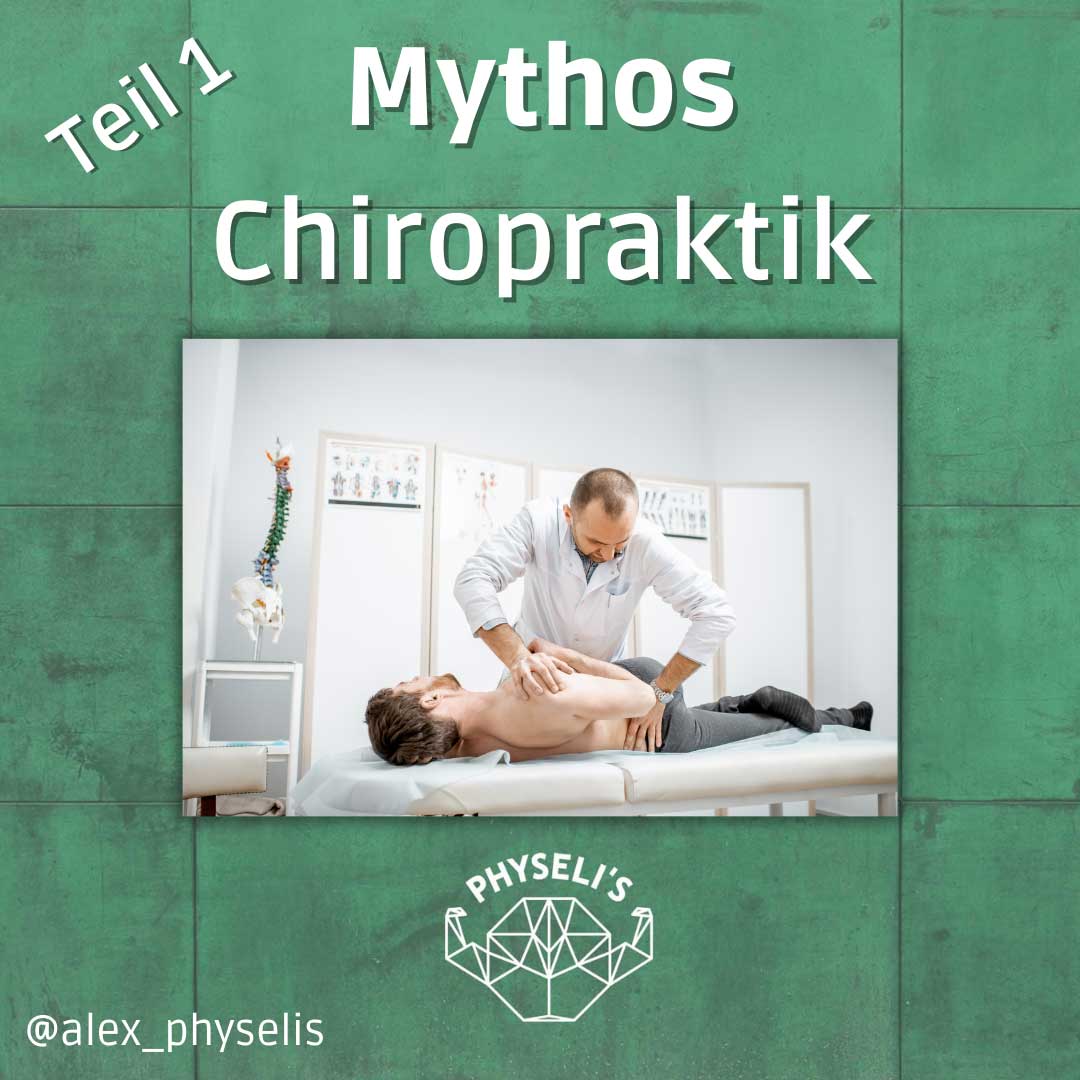Introduction
In Part 1, we looked at the history and explanatory model of chiropractic.
We learned that there is no scientific evidence for the basic assumption of chiropractic, the subluxations of individual vertebral bodies, and that it is not anatomically plausible.
In Part 2, we will look at the actual mechanism of action behind such treatment and when chiropractic interventions can actually be dangerous. Disclaimer: We do not wish to attack any individual, but rather to compare the general working methods of chiropractic with the current data. Chiropractic interventions consist of so-called spinal manipulations (SM).
This involves applying a rapid impulse to a specific tissue with high force and therapeutic intent.
Spinal manipulations are not a chiropractic invention and are also used by other professional groups in practice.
Results
There have already been several reviews in the literature that have looked at the effect strength of spinal manipulation, some of which describe different results.
Two Cochrane Reviews on low back pain conclude that there is no clinically relevant difference between SM, other interventions and placebo treatment for pain relief and functional improvement.
A paper by Chaibi et al.
(2021) on acute neck pain found that SM can be a possible treatment alongside other interventions.
However, all studies have in common that they criticize the overall small number and low quality of studies as well as the dubious reliability of the results.
Mechanism of action
The exact mechanism of action has not yet been fully clarified.
The possible effects of these treatments are manifold.
The key reason for an improvement in symptoms following manipulation appears to be at the neurophysiological level.
The mechanical stimulation of spinal manipulation generates a series of inputs to the posterior horn of the spinal cord, which in turn triggers a cascade of neuronal responses involving complex interactions between the peripheral and central nervous systems.
This can result in an altered perception of symptoms and pain relief.
Effects at the biomechanical level are also described (e.g. increased diffusion into the intervertebral disc space).
In addition, social effects such as the expectation of treatment success, the therapeutic alliance and other contextual factors are important.
Problems
However, it is unclear how long these effects last.
A study from 2020 by Thomas et al.
found no significant differences between spinal manipulation, spinal mobilization and placebo treatment at a follow-up of 48-72 hours or 4 weeks after treatment.
A new review from 2023 by Sørensen et al.
also confirmed the assumption that it makes no difference whether the manipulation is applied at a specific vertebral level or a non-targeted approach is used.
This fact speaks against the hypothesis that a local, segmental effect in the tissue or joint is decisive for the success of the treatment.
Which (as a reminder) is the basic thesis of chiropractic.
There are other problems: The reliability of examination methods used in chiropractic is generally very low.
As this is already known in chiropractic, many patients are routinely subjected to X-ray examination.
This is not compatible with current guideline recommendations, as imaging procedures for back or neck complaints are often unnecessary and can also be harmful.
Nocebos
The frequently detrimental way of communicating in chiropractic and the resulting nocebos must also be viewed critically.
Nocebos are negative effects that occur after a treatment has been administered due to mechanisms such as patient expectations.
Examples in chiropractic would be the following:
- Reinforcing the false conviction about the necessity of imaging procedures
- Negative unrealistic predictions (e.g. progression of symptoms is inevitable without chiropractic)
- Dependence on treatments – superfluous contracts for long-term treatments with a high financial burden
Risks
There are now correlations between spinal manipulation of the cervical spine and the injury of blood vessels and subsequently the development of a stroke.
A 2009 review by Gouveia et al.
found that previous studies had grossly misclassified cases of arterial injury associated with manipulation.
The risk of suffering a stroke following SM to the cervical spine is higher than previously assumed (especially in young people).
However, the lack of data on this topic is a major problem.
Chiropractic is heavily criticized for the lack of documentation and processing of side effects, which is why no clear assessment of the probability of risk and no definitive causal relationship can be established.
It should also be mentioned that medical treatments are never completely free of side effects (e.g. with medication).
This is why this is also referred to as a risk-benefit ratio.
Due to the very small but still existing risk of an arterial injury and no long-term effect of the treatment, it is advisable to consider this ratio carefully before making use of chiropractic interventions (on the cervical spine).
Conclusion
Current chiropractic practice raises many concerns due to the following points:
- Incomplete proof of efficacy
- High probability of no long-lasting effects
- Inadequate investigation methods
- Excessive, superfluous use of imaging procedures
- High risk of incorrect diagnoses
- High risk of nocebos: – conveying an unrealistic body image – reducing patients’ self-efficacy
- High risk of becoming dependent on treatment – which may result in a high financial burden
- Probably low, but not yet fully clarified risk of serious side effects
- In view of the current data situation, the value of this popular method as a health service should be increasingly questioned.
Sources:
- Cai, X., Razmara, A., Paulus, J.K., Switkowski, K., Fariborz, P.J., Goryachev, S.D., D’avolio, L., Feldmann, E., & Thaler, D. E. (2014).
Case misclassification in studies of spinal manipulation and arterial dissection.
Journal of Stroke and Cerebrovascular Diseases: The Official Journal of National Stroke Association, 23(8), 2031-2035. https://doi.org/10.1016/jstrokecerebrovasdis.2014.03.007 - Chaibi, A., Stavem, K., & Russell, M. B. (2021).
Spinal manipulative therapy for acute neck pain: A systematic review and meta-analysis of randomized controlled trials.
Journal of Clinical Medicine, 10(21), 5011. https://doi.org/10.3390/jcm10215011 - Ernst, E. (2008).
Chiropractic: A critical evaluation.
Journal of Pain and Symptom Management, 35(5), 544-562. https://doi.org/10.1016/j.jpainsymman.2007.07.004 - Gevers-Montoro, C., Provencher, B., Descarreaux, M., Ortega de Mues, A., & Piché, M. (2024).
Neurophysiological mechanisms of chiropractic spinal manipulation for spine pain: European Journal of Pain (London, England), 25(7), 1429-1448. https://doi.org/10.1002/ejp.1773 - Gouveia, L. O., Castanho, P., & Ferreira, J.J. (2009).
Safety of chiropractic interventions: A systematic review.
Spine, 34(11), E405-E413. https://doi.org/10.1097/brs.0b013e3181a16d63 - Gyer, G., Michael, J., Inklebarger, J., & Tedla, J. S. (2019).
Spinal manipulation therapy: Is it all about the brain?
A current review of the neurophysiological effects of manipulation.
Journal of Integrative Medicine, 17(5), 328-337. https://doi.org/10.1016/j.joim.2019.05.004 - Hohenschurz-Schmidt, D., Thomson, O. P., Rossettini, G., Miciak, M., Newell, D., Roberts, L., Vase, L., & Draper-Rodi, J. (2022).
Avoiding nocebo and other undesirable effects in chiropractic, osteopathy and physiotherapy: An invitation to reflect.
Musculoskeletal Science & Practice, 62(102677), 102677. https://doi.org/10.1016/j.msksp.2022.102677 - Minnucci, S., Innocenti, T., Salvioli, S., Glagio, S., Yousif, M. S., Riganelli, F., Carletti, C., Feller, D., Brindisino, F., Faltiera, A., Chiarotto, A., & Mourad, F. (2023).
Benefits and harms of spinal manipulative therapy for treating recent and persistent nonspecific neck pain: A systematic review with meta-analysis.
The Journal of Orthopaedic and Sports Physical Therapy, 53(9), 10-528. https://doi.org/10.2519/jospt.2023.11708 - Nim, C. G., Downie, A., O’Neill, S., Kawchuk, G. N., Perle, S. M., & Leboeuf-Yde, C. (2024).
The importance of selecting the correct site to apply spinal manipulation when treating spinal pain: Myth or reality?
A systematic review.
Scientific Reports, 11(1), 23415. https://doi.org/10.1038/s41598-021-02882-2 - Randoll, C., Gagnon-Normandin, V., Tessier, J., Bois, S., Rustamov, N., O’Shaughnessy, J., Descarreaux, M., & Piché, M. (2017).
The mechanism of back pain relief by spinal manipulation relies on decreased temporal summation of pain.
Neuroscience, 343, 220-228. https://doi.org/10.1016/j.neuroscience.2017.03.006 - Rubinstein, S. M., Terwee, C. B., Assendelft, W.J.J., de Boer, M. R., & van Tulder, M. W. (2012).
Spinal manipulative therapy for acute low-back pain.
The Cochrane Library. https://doi.org/10.1002/14651858.cd008880.pub2 - Rubinstein, S. M., van Middelkoop, M., Assendelft, W.J.J., de Boer, M.R., & van Tulder, M. W. (2011).
Spinal manipulative therapy for chronic low-back pain.
The Cochrane Library. https://doi.org/10.1002/14651858.cd008112.pub2 - Sorensen, P. W., Nim, C. G., Poulsen, E., & Juhl, C. S. (2023). Spinal manipulative therapy for nonspecific low back pain: Does targeting a specific vertebral level make a difference?: A systematic review with meta-analysis. The Journal of Orthopaedic and Sports Physical Therapy, 53(9), 529-539. https://doi.org/10.2519/jospt.2023.11962
- Thomas, J.S., Clark, B. C., Russ, O. W., France, C.R., Ploutz-Snyder, R., Corcos, D. M., & for the RELIEF Study Investigators.
(2020).
Effect of spinal manipulative and mobilization therapies in young adults with mild to moderate chronic law back pain: A randomized clinical trial.
JAMA Network Open, 3(8), 2012589. https://doi.org/10.1001/jamanetworkopen.2020.12589
💚Do you need support with your workout, rehabilitation after injury or just want to feel more comfortable and healthy in your body overall? Check out our offer or book a free online consultation.⠀




